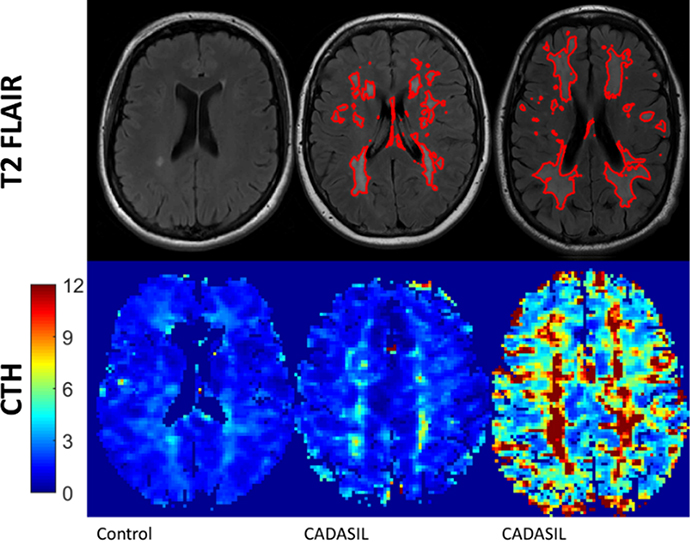Capillary Dysfunction: A new disease entity
The brain and the peripheral nervous system rely on a steady supply of oxygen to meet their high metabolic demands. Currently, ischemia is central to our understanding of vascular disease, and radiological examinations therefore focus on detecting flow-limiting conditions, reduced tissue perfusion, and evidence of ischemic injury in patients with suspected cerebrovascular disease.
Our research group discovered that capillary transit time heterogeneity (CTH) is as important for tissue oxygenation as its blood supply. Similar to larger vessels, ageing and vascular risk factors also affect the morphology and function of capillaries. Also, the function of individual capillaries is affected in conditions such as cancer, sepsis, inflammation, and dementia. The resulting changes in CTH may cause severe reductions in tissue oxygenation as in ischemia – but undetectable by our current diagnostic techniques.
To address the importance of this capillary dysfunction phenomenon, we have performed extensive literature reviews to examine whether capillary dysfunction plays a role in major diseases. Other than histopathological evidence of capillary damage, defining features of capillary dysfunction include pre-symptomatic hyperemia, paradox hypoxic tissue injury at high blood flow, and symptom deterioration (pain, neurological symptoms) under conditions that affect capillary, rather than arterial flow (e.g. moderately increased ICP, leukocytosis, blood viscosity).
In parallel, we have developed indicator-dilution methods to determine transit time distributions based on MR and CT perfusion measurements in humans, and based on dynamic two-photon imaging of small cortical arteries and veins during fluorescent contrast injections in rodent cortex. Typical MR image voxels contain thousands of capillary segments, and we therefore conduct parallel studies in rodents and humans to ensure that findings, particularly their potential impact on tissue oxygenation, are consistent across these scales.
Our literature reviews revealed strong indications of capillary dysfunction in a range of conditions ranging from stroke, delayed ischemia after subarachnoid hemorrhage (SAH), cerebral small vessel disease, and Alzheimer’s Disease (AD) to traumatic brain injury, cancer, diabetic neuropathy, heart disease, critical illness, stress and depression.
With our new methods, we have so far confirmed these hypotheses in patients with AD, stroke, carotid stenosis, small vessel disease, and brain tumors, and in animal models of AD, stroke, and delayed ischemia after SAH. Needless to say, much work needs to be done before we have uncovered this overlooked disease mechanism and understand how it will affect future diagnostics and therapy for patients.

The figure shows FLAIR images (top row) with distinct WMHs in a middle-aged control subject (left) and confluent areas in two CADASIL patients (middle, right). The rightmost patient suffers from much more severe cognitive deficits than the middle patient, although their WMH loads are similar. The lower row shows measurements of capillary dysfunction, as indexed by capillary transit-time heterogeneity (CTH). Note the widespread, extensive capillary dysfunction in the rightmost patient, as indicated by the warmer colours throughout the brain slice (unpublished data, courtesy of Keith Muir, Thorbjørn S. Engedal).
References
- Anzabi M, Angleys H, Aamand R, Ardalan M, Mouridsen K, Rasmussen PM, Sørensen JCH, Plesnila N, Østergaard L, Iversen NK. Capillary flow disturbances after experimental subarachnoid hemorrhage: A contributor to delayed cerebral ischemia? Microcirculation. 2019; 26(3):e12516. doi: 10.1111/micc.12516.
- Stadlbauer A, Mouridsen K, Doerfler A, Bo Hansen M, Oberndorfer S, Zimmermann M, Buchfelder M, Heinz G, Roessler K. Recurrence of glioblastoma is associated with elevated microvascular transit time heterogeneity and increased hypoxia. J Cereb Blood Flow Metab. 2018; 38(3):422-432. doi: 10.1177/0271678X17694905.
- Engedal TS, Hjort N, Hougaard KD, Simonsen CZ, Andersen G, Mikkelsen IK, Boldsen JK, Eskildsen SF, Hansen MB, Angleys H, Jespersen SN, Pedraza S, Cho TH, Serena J, Siemonsen S, Thomalla G, Nighoghossian N, Fiehler J, Mouridsen K, Østergaard L. Transit time homogenization in ischemic stroke - A novel biomarker of penumbral microvascular failure? J Cereb Blood Flow Metab. 2018; 38(11):2006-2020. doi: 10.1177/0271678X17721666.
- Lauer A, Da X, Hansen MB, Boulouis G, Ou Y, Cai X, Liberato Celso Pedrotti A, Kalpathy-Cramer J, Caruso P, Hayden DL, Rost N, Mouridsen K, Eichler FS, Rosen B, Musolino PL. ABCD1 dysfunction alters white matter microvascular perfusion. Brain. 2017; 140(12):3139-3152. doi: 10.1093/brain/awx262.
- Nielsen RB, Egefjord L, Angleys H, Mouridsen K, Gejl M, Møller A, Brock B, Brændgaard H, Gottrup H, Rungby J, Eskildsen SF, Østergaard L. Capillary dysfunction is associated with symptom severity and neurodegeneration in Alzheimer's disease. Alzheimers Dement. 2017;13(10):1143-1153. doi: 10.1016/j.jalz.2017.02.007.
- Tietze A, Mouridsen K, Lassen-Ramshad Y, Østergaard L. Perfusion MRI derived indices of microvascular shunting and flow control correlate with tumor grade and outcome in patients with cerebral glioma. PLoS One. 2015 Apr 13;10(4):e0123044. doi: 10.1371/journal.pone.0123044.
Contacts
Professor Leif Østergaard, email: leif@cfin.au.dk
Professor Kim Beuchau Mouridsen, email: kim@cfin.au.dk
Professor Sune Nørhøj Jespersen, email: sune@cfin.au.dk
Associate professor Nina Kerting Iversen, email: nkiversen@cfin.au.dk
Post doc Eugenio Gutierrez-Jimenez, email: eugenio@cfin.au.dk